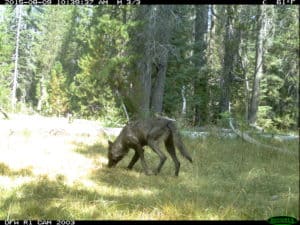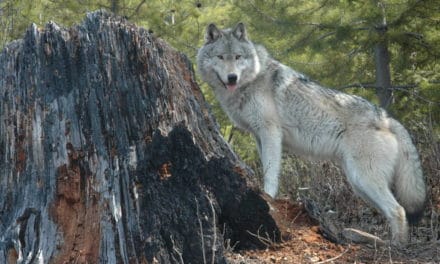By Melissa Wynn
For decades the gray wolf was thought to be absent from the great wildernesses of Northern California. So, there was great excitement in 2011 when the radio collared, gray wolf dubbed OR7 crossed the border from Oregon on December 28th and began to explore our neck of the woods. He wandered portions of the Modoc Plateau, in the Lassen and Plumas National Forests, and meandered as far south as Tehama, Shasta, and Butte counties. This intrepid lone wolf captured the hearts of Californians and we celebrated his presence each time he visited from Oregon. As is the natural order of things, OR7 returned to Oregon in 2013 for the last time and started a pack of his own, leaving us once again seemingly without wolves.

Hope returned August 3, 2015 when the California Department of Fish & Wildlife reported that evidence pointed once again to at least one wolf in our neighborhood. The press release stated in part “Based on compelling information received earlier this year from Californians reporting they saw a large, dark-colored canid, CDFW deployed a number of remote trail cameras within southeastern Siskiyou County. At one location, in early May, images were captured of a large, dark-colored, lone canid, which is possibly a dispersing gray wolf.” It went on to say that “In early June, CDFW biologists came across large canid tracks on a dirt road in a separate, remote location of Siskiyou County, while searching for fawns as part of an ongoing deer study.”
Additional trail cameras were deployed and on July 24, CDFW downloaded a series of images from one of those cameras, taken the previous week, revealing a large, dark-colored canid that they believed to be another lone gray wolf.
Confirmation of not only a single gray wolf, but a pack of our own came with another press release from CDFW on August 20th announcing new photographic evidence showing five, playful gray wolf pups, estimated to be a few months old, and two adults at home in Siskiyou County.
Like other members of the canine family, gray wolves come in a variety of colors. While OR7 was a stunning silver, the majority of this family named the Shasta Pack, have coats of a smokey black.
Although they differ in color, DNA testing confirmed that the breeding female comes from the Imnaha Pack of Northeastern Oregon, the same pack that gave us the famous OR7.

In June 2014, the California Fish and Game Commission voted to list gray wolves as endangered under the California Endangered Species Act. The gray wolf is also listed as endangered in California, under the Federal Endangered Species Act of 1973. Gray wolves in California are therefore protected by the ESA making it illegal to harass, harm, pursue, hunt, shoot, wound, kill, trap, capture or collect wolves, or to attempt to engage in any such conduct in California.
In addition to the data collected on their trail cameras, CDFW relies on all of us to learn all they can about wolves in California. If you think you see a wolf try to snap a photo and post your sighting on the CDFW gray wolf website at www.wildlife.ca.gov/Conservation/Mammals/Gray-Wolf/Sighting-Report.
CDFW also reminds us to never approach, feed or otherwise disturb a wolf, especially those with pups. For more information about staying safe in our newly wolf-occupied area, including what people should do if they encounter a wolf, please visit www.wildlife.ca.gov/Conservation/Mammals/Gray-Wolf/FAQ.”












